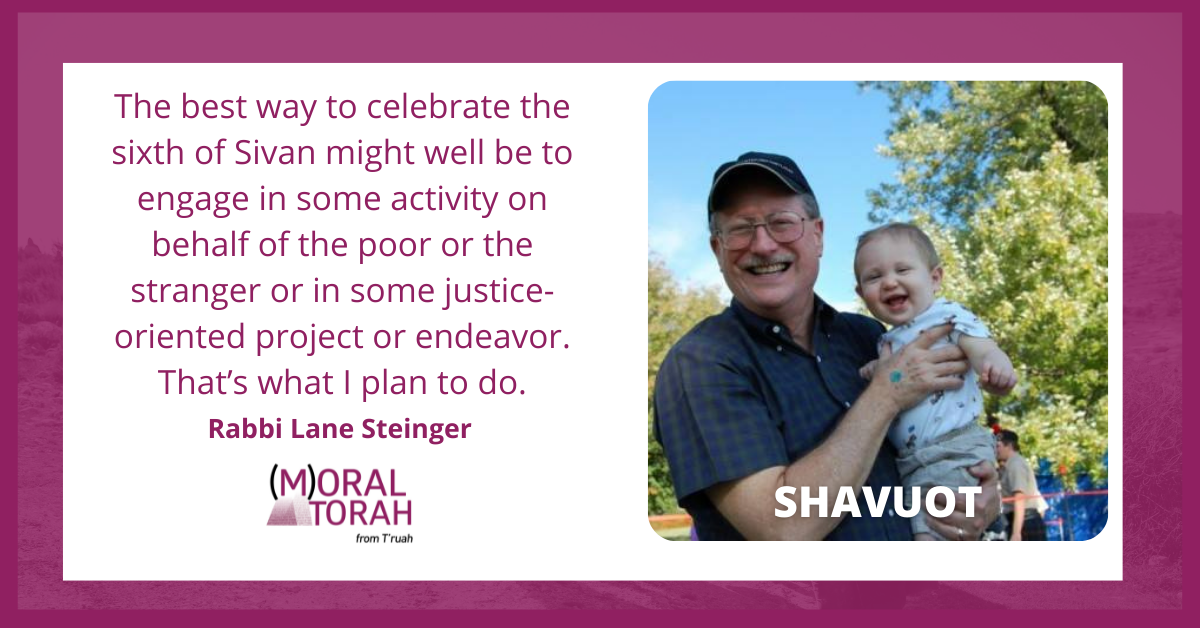A D’var Torah for Shavuot by Rabbi Lane Steinger
I am fascinated by names, and so I am struck by the multiple names for our late spring holiday, the third of the Shalosh R’galim, our Three Pilgrimage Festivals (Exodus 23:14-17; Deuteronomy 16:16-17). The Torah gives it three titles: Chag Hakatzir, the Feast of Reaping (Exodus 23:16); Chag Shavuot, the Feast of Weeks (Exodus 34:22; Numbers 28:26; Deuteronomy 16:10,16); and Yom Habikkurim, the Day of First Fruits (Numbers 28:26; cf. Exodus 23:16). At least two of the three indicate the agricultural roots of this holy day.
Whatever its biblical name, this festival differs from the other two pilgrimages. It is only one day rather than a week long. Unlike for Pesach and Sukkot, the Torah specifies no set date for it, nor is it connected to the mythic history of the people of Israel.
By the late first century CE, the festival had acquired two additional names: “Atzeret” and, among Greek-speaking Jews, “Pentecost,” “the Fiftieth Day.” Thus Josephus wrote,
When a week of weeks has passed after this [paschal] sacrifice, which weeks contain forty-nine days, … the fiftieth day… is Pentecost, but is called by the Hebrews Atzeret… (Antiquities Of The Jews III:10:6)
Sign up to receive (M)oral Torah in your inbox each week.
Why “Atzeret”? In the Torah there are two applications. One is [Shmini] Atzeret – the [Eighth Day of] Conclusion following the week of Sukkot (Leviticus 23:36,39; Numbers 29:35; see also Nehemiah 8:18; 2 Chronicles 7:9); the other is the seventh and, according to Deuteronomy, the concluding day of Pesach (Deuteronomy 16:8). Nowhere does the Torah (or the Bible more broadly) apply “Atzeret” to the third of the three pilgrimages.
Yet our sages did. In rabbinic Judaism the holiday eventually became associated with the Torah and Sinai: “Atzeret is the day on which the Torah was given” (Pesachim 68b). Our sages would bestow the liturgical name, “Z’man Matan Torateinu — The Time of the Giving of Our Torah,” and also fix the date as the sixth of Sivan (see Shabbat 86b; Menachot 65a-66a); nevertheless, they curiously continued to call it Atzeret (as, e.g., in Rosh Hashanah 1:2 and the preceding Gemara on 1:1).
Our rabbis saw parallels between this Atzeret and the two specified in the Torah. Just as Shmini Atzeret followed the festivities of the major harvest festival and the seventh day of Pesach ended Passover, so this Atzeret concluded and completed the grain harvests and Sefirat HaOmer, the Counting of the Sheaf symbolically enumerating the 50 days.
There is another aspect to the rabbis’ usage of Atzeret for our festival. The noun “Atzeret” appears twice more in our Bible. In Jeremiah 9:1, the word is purely poetic and does not pertain to a sacred occasion. The other instance of Atzeret (in the plural) is found in the book of Amos.
I reject, I spurn your festivals,
And will not savor your Atzerets.
Your burnt-offerings and meal offerings I will not favor;
Offerings of well-being and your fatlings I will not regard.
Remove from Me the sound of your songs;
The music of your instruments I will not hear.
But let justice well up like water,
And what is right like an ever flowing stream. (Amos 5:21-24)
Here the prophet directs the divine word to those who deem ritual unaccompanied by pursuit of justice sufficient as service to God. Not so, declares Amos: justice, like water, is elemental. Without it nothing can endure. It must be part of the spiritual landscape, like a gushing spring or a wadi which never dries up. So Amos indicts Judah and Israel, equating “their spurning of the Torah of the ETERNAL” with “crushing the heads of the vulnerable on the dust of the earth” and other inequities (see 2:4-8).
Find more commentaries on Shavuot.
I venture to say that when many Jews think of our festival on the sixth of Sivan, they don’t consider justice to be at the heart of the holiday (perhaps another difference between Shavuot on one hand and Pesach and Sukkot on the other). Amos’ linking of Atzeret to justice helps me make that connection. Justice is actually basic to the festival. For example, recall that the first name for our festival we find in the Torah is Chag Hakatzir – the Feast of the Reaping. Its description in Leviticus ends with this verse
When you reap the cuttings of your land, you shall not harvest the edges of your field in your reaping or gather the gleanings of your reaping, but you shall leave them for the poor and the stranger; I am the ETERNAL your God. (Leviticus 23:22)
 The best way to celebrate the sixth of Sivan might well be to engage in some activity on behalf of the poor or the stranger or in some justice-oriented project or endeavor. That’s what I plan to do.
The best way to celebrate the sixth of Sivan might well be to engage in some activity on behalf of the poor or the stranger or in some justice-oriented project or endeavor. That’s what I plan to do.
Chag Hakatzir, Yom Habikkurim, Shavuot, Pentecost, Z’man Matan Torateinu, and Atzeret. May we acknowledge and appreciate all the names for our festival on the sixth of Sivan. And may its appellation “Atzeret” especially encourage and inspire us to renew our efforts for justice and equity.
Lane Steinger was ordained at HUC-JIR, Cincinnati, and is Rabbi Emeritus of Shir Hadash Reconstructionist Community in St. Louis.

